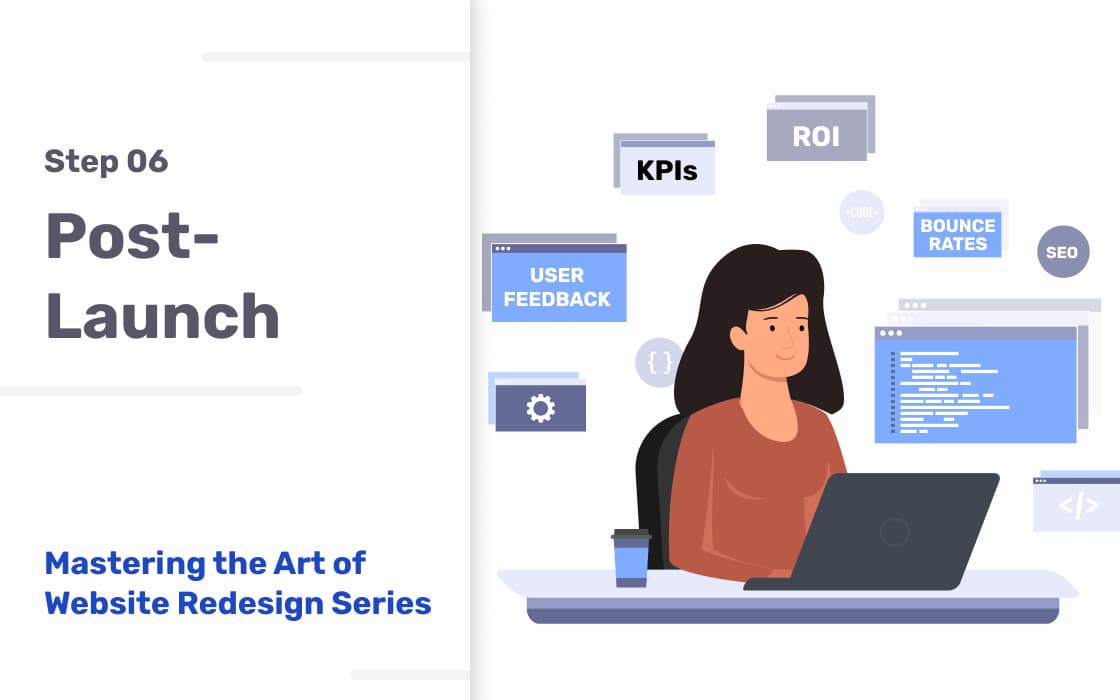Congratulations, your website has been redesigned and launched! But, as any seasoned web professional will tell you, the journey doesn’t end here. Welcome to “Post-Launch: Measuring Success and Planning for the Future,” where we explore the vital steps to take after your website goes live.
I’m Shaun, and with over two decades in the field of web development and design, I’ve learned that a successful website is a constantly evolving entity. In this article, we will delve into the crucial post-launch phase, which is as important as the redesign process itself. It’s here that you truly gauge the effectiveness of your new website and lay the groundwork for ongoing success.
We’ll discuss how to track key metrics to measure the success of your redesign, the importance of gathering user feedback, and the necessity of making iterative improvements. Additionally, we’ll cover the essentials of planning for regular updates and maintenance to ensure your website remains dynamic, secure, and aligned with the latest web standards and trends.
Embarking on this post-launch journey is crucial for keeping your website not just functional, but thriving and responsive to the ever-changing digital landscape. Let’s dive in and set the stage for continued growth and innovation.
Metrics to Track Post-Redesign Success
It’s easy to advise clients to monitor their website analytics, but the key to ensuring that this turns into a cycle of continuous improvement lies in a two-fold approach. Firstly, continue regular meetings post-launch to review the site’s performance. In my experience, providing focused analytics at 30, 60, and 90 days post-launch helps establish new benchmarks for the site. Secondly, set up automated reporting to regularly remind clients to pay attention to specific metrics. These reports can become a valuable tool in their internal meetings, keeping the website’s performance front and center.
- Defining Key Performance Indicators (KPIs): Identify KPIs that align with your website’s objectives. These could range from user engagement and conversion rates to traffic growth, providing insight into how well the site is meeting its goals.
- Traffic and Engagement Metrics: Monitor changes in traffic, including new and returning users. Assess engagement through metrics like session duration and pages per session. An improvement in these areas post-redesign often signals a successful user response.
- Conversion Rates: Conversion rate tracking is crucial to measure how effectively the site turns visitors into customers. Post-redesign improvements here indicate that the site is successfully achieving its business objectives.
- Bounce Rates: A lower bounce rate post-redesign can suggest that users are finding the new site more engaging and navigable.
- SEO Performance: Observe any changes in search engine rankings and organic traffic, as these are indicators of the redesign’s impact on SEO.
- User Feedback: Incorporate qualitative data from user feedback to gain insights beyond what quantitative metrics can provide.
- ROI Calculation: If possible, evaluate the ROI of the redesign by comparing its cost against the value of improvements, such as increased sales or engagement.
By actively monitoring these metrics and leveraging regular reporting, you can measure the success of your website redesign and foster a culture of ongoing analysis and improvement. This approach ensures your site continues to evolve in line with user needs and business goals.
Gathering User Feedback and Making Iterative Improvements
The post-launch phase of a website redesign is an ideal time to gather user feedback and make iterative improvements. This process ensures that your website doesn’t just meet but exceeds user expectations.
- Importance of User Feedback: User feedback is invaluable in understanding how your redesigned website is received by its actual users. It offers insights into user needs, preferences, and pain points, which might not be apparent through quantitative data alone.
- Methods for Gathering Feedback: Employ a variety of methods to collect feedback. This can include user surveys, feedback forms on the website, social media listening, and usability testing sessions. Each method can provide different insights, contributing to a comprehensive understanding of user experience.
- Analyzing Feedback for Actionable Insights: Once collected, systematically analyze the feedback to identify common themes and specific areas needing improvement. This analysis should guide the prioritization of changes to be made.
- Implementing Iterative Changes: Based on the feedback, implement changes in an iterative manner. Prioritize updates that will have the most significant impact on user experience and business goals. This approach allows for continuous refinement and ensures that changes are manageable and effective.
- Communicating Changes to Users: Inform your users about the changes being made, especially if the feedback came directly from them. This communication can be through website updates, emails, or social media posts. It demonstrates that you value user input and are committed to enhancing their experience.
- Measuring the Impact of Changes: After implementing changes, measure their impact through the same metrics and methods used to track the overall success of the website. This will help assess the effectiveness of the improvements and inform future iterations.
- Encouraging Ongoing Feedback: Establish a culture of continuous feedback even beyond the initial post-launch phase. Regular user feedback can be an ongoing source of insights for continual improvement.
By actively gathering and responding to user feedback, you can ensure that your website remains user-centric and continuously evolves to meet changing needs and expectations. This iterative process of improvement is crucial for maintaining a relevant and engaging online presence.
Planning for Regular Updates and Maintenance
To keep your website at peak performance and relevance, regular updates and maintenance are non-negotiable. This ongoing process is vital in ensuring your website remains a dynamic and effective tool for your business.
- Regular Conversations with Web Partners: Establishing a regular communication rhythm with your web partners is crucial. Whether it’s weekly, monthly, or quarterly, these scheduled check-ins can make a significant difference. They create a structured opportunity to discuss the backlog of ideas and improvements, updates from third-party integrations, and other emerging opportunities. This “forced communication rhythm” keeps everyone aligned and proactive.
- Regular Updates: Regular updates are essential for security, functionality, and keeping up with web standards. They also keep your content fresh and engaging for your audience.
- Maintenance Plan: Develop a detailed maintenance plan outlining schedules for updates, including security patches, software updates, and content revisions. Assign clear responsibilities for each maintenance aspect.
- Content Update Strategy: Plan for continuous content updates to enhance engagement and SEO. This involves reviewing and refreshing existing content and adding new, relevant content regularly.
- Security and Technical Maintenance: Regularly conduct security audits, update protective measures, and address vulnerabilities promptly. Technical maintenance should also focus on the website’s hosting environment and overall performance.
- Performance Monitoring and Optimization: Continuously monitor website performance metrics. Use these insights to optimize the site, ensuring fast load times and a smooth user experience.
- Budgeting for Ongoing Maintenance: Allocate a dedicated budget for maintenance and updates. This is an essential part of your website’s operational costs and, if managed well, can prevent larger expenses in the future.
- Staying Current with Web Trends: Keep updated with the latest in web technology and trends. Regularly assess and integrate relevant new features to keep your website up-to-date and effective.
By engaging in regular discussions with your web partners and planning for ongoing updates and maintenance, you not only maintain the health of your website but also open the door to continuous improvement and innovation.
Conclusion
The launch of your redesigned website marks the beginning of an ongoing journey of growth and adaptation. As we’ve explored in “Post-Launch: Measuring Success and Planning for the Future,” the key to sustaining this journey lies in diligent monitoring, regular communication, and proactive maintenance.
Tracking key metrics, actively seeking user feedback, and making iterative improvements are crucial steps in understanding and enhancing your website’s performance. These actions allow you to respond effectively to user needs and changing market dynamics, keeping your website relevant and engaging.
Equally important is the regular dialogue with your web partners. Whether weekly, monthly, or quarterly, these conversations ensure that everyone stays aligned with the website’s goals and is aware of upcoming opportunities or necessary updates. This rhythm of communication not only maintains the health of your website but also fosters a culture of continuous improvement.
And finally, planning for regular updates and maintenance is not just about fixing what’s broken; it’s about anticipating changes, embracing new trends, and always staying a step ahead. It’s a commitment to never letting your website become stagnant.
As you move forward, remember that your website is a living entity in the digital ecosystem, constantly evolving and growing. With the strategies outlined in this article, you’re equipped to ensure that this evolution is a path to success and excellence.
Mastering the Art of Website Redesign Series
To Redesign or Not
In the ever-evolving world of the internet, the question isn’t just about having a website but whether it’s time to give that site a facelift. But here’s a twist:

